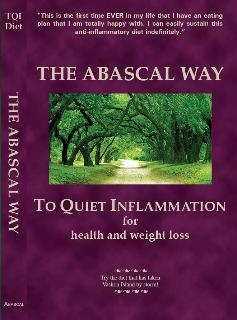I’ve long been wary of diets that forbid that trinity of culinary pleasure—dairy, wheat, sugar. Physical pain is a powerful incentive for change, but can changing your diet truly provide a cure? Then a friend with arthritis gave a glowing account of her own nutritional overhaul, an approach called The Abascal Way.
I remembered that a book by that very name had been sitting in the library, on a shelf in my line of vision for at least a month. The next time I was in the library, I found this book, took it home, and put it on my dining room table, where it sat for another week and a half, unopened. Having such a book is one thing; reading it is what threatens the status quo.
Then I spent an entire day in a meditation workshop, and when I got home, I picked up The Abascal Way and began to go through it. The next morning I started the diet.
I wasn’t committed to actually doing the diet, you understand. I was just going to put a couple of the principles into practice: a breakfast with no grains; a breakfast that’s half protein and half fruit or vegetables. It stretched my ingenuity to come up with such a breakfast, but I did. That first morning I ate fried eggs and kale.
Later in the day two friends from Seattle dropped in. I mentioned this impossible new eating plan—No grains, indeed! What other breakfasts are there?—and it turned out Alice and Jane had been following this diet for a year, they’d taken Abascal workshops online, they knew the founder’s story.
Kathy Abascal lives on nearby Vashon Island, a lawyer who also studied neurobiology and botanical medicine. To deal with her own health issues, she developed a nutritional program she describes in her books and now teaches in that online class called TQI—To Quiet Inflammation.
I got more serious about my new diet. It was now my new diet. A few weeks ago, I wrote about how I’d stopped eating chocolate and almost immediately started having less arthritic pain in my right foot. But less pain is not the same as painless, and this is what I’m shooting for. I’ve been on the Abascal diet—and truly on it since that first day—for three weeks now. My newly un-inflamed foot is a joy to walk on.
What is most interesting to me is why it took me so long to let go of culinary crutches that I knew, intuitively, weren’t good for my body.
Chai, for instance, is an Indian-style tea I was drinking in quantity every day. I’ve loved this sweet, strong, milky, spiced concoction since the first time I tasted it, forty years ago. And I’d been telling myself, “This isn’t so bad.” The spices—ginger, cardamom, fennel, clove, cinnamon—are medicinal, and I was replacing the milk with soy creamer and the sugar with stevia. In her book, Abascal points out that packaged foods have additives. The third ingredient listed for that creamer is, I found, cane syrup—no wonder it tastes so yummy! As for stevia, Abascal writes that, from the body’s standpoint, sweet is sweet.
I let go of chai that first morning—you can do anything for one day—and found I could finally taste the black tea, which has quite an interesting flavor all its own. Now I look forward to a cup of tea in the morning, and because it’s not sweet, I don’t keep drinking it all morning long.
While I’ve overcome a few hurdles, I know there are more a ahead. I’m now facing my three favorite culinary holidays: Christmas, Thanksgiving, and Halloween!
I just have to find a way to remind myself that inflammation is a pain.

